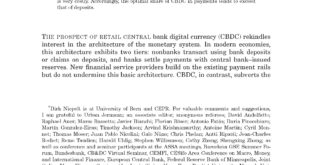An executive order issued on January 23, 2025, aims at protecting “Americans from the risks of Central Bank Digital Currencies (CBDCs), which threaten the stability of the financial system, individual privacy, and the sovereignty of the United States, including by prohibiting the establishment, issuance, circulation, and use of a CBDC within the jurisdiction of the United States.” The executive order defines CBDC as “a form of digital money or monetary value, denominated in the national...
Read More »“Money and Banking with Reserves and CBDC,” JF, 2024
Journal of Finance. HTML (local copy). Abstract: We analyze the role of retail central bank digital currency (CBDC) and reserves when banks exert deposit market power and liquidity transformation entails externalities. Optimal monetary architecture minimizes the social costs of liquidity provision and optimal monetary policy follows modified Friedman rules. Interest rates on reserves and CBDC should differ. Calibrations robustly suggest that CBDC provides liquidity more efficiently than...
Read More »Bank of England CBDC Academic Advisory Group
The Bank of England and HM Treasury have formed a CBDC Academic Advisory Group (AAG). The AAG will bring together a diverse, multi-disciplinary group of experts to encourage academic research, debate and promote discussion on a range of topics, to support the Bank and HM Treasury’s work during the design phase of a digital pound. Members: Alexander Edmund Voorhoeve Professor of Philosophy London School of Economics Alistair Milne Professor of Financial Economics Loughborough University...
Read More »Panel on “Will the digital euro take off?,” CEPR, 2023
Katrin Assenmacher (ECB), Peter Bofinger (U of Wurzburg), Rod Garratt (UCSB, BIS), Alexandre Stervinou (Banque de France). Chair: Dirk Niepelt. One of the opening events at CEPR’s Paris Symposium 2023. Organizer: Tessa Ogden, Dirk Niepelt.
Read More »Conference on “The Macroeconomic Implications of Central Bank Digital Currencies,” CEPR/ECB, 2023
Conference jointly organized by CEPR’s RPN FinTech & Digital Currencies and the European Central Bank. Welcome speech by Piero Cippolone, keynote by Fabio Panetta. Organizers: Toni Ahnert, Katrin Assenmacher, Massimo Ferrari Minesso, Peter Hoffmann, Arnaud Mehl, Dirk Niepelt. CEPR’s conference website. ECB’s website with videos. Website with pictures.
Read More »Panel on the Economics of CBDC, Riksbank, 2023
Panel at the Bank of Canada/Riksbank Conference on the Economics of CBDC, November 16, 2023. Video. Fed Governor Christopher Waller, UCSB professor Rod Garratt and myself assess the case for central bank digital currency and stable coins and respond to excellent questions from the audience.
Read More »“A Macroeconomic Perspective on Retail CBDC and the Digital Euro,” EIZ, 2023
In Christos V. Gortsos and Rolf Sethe, editors: Central Bank Digital Currencies, EIZ Publishing, ch. 3, Zurich, October 2023. PDF.
Read More »“Retail CBDC and the Social Costs of Liquidity Provision,” VoxEU, 2023
VoxEU, September 27, 2023. HTML. From the conclusions: … it is critical to account for indirect in addition to direct social costs and benefits when ranking monetary architectures. … the costs and benefits we consider point to an important role of central bank digital currency in an optimal monetary architecture unless pass-through funding is necessary to stabilise capital investment and very costly. … the interest rate on CBDC should differ from zero and from the rate on reserves. From...
Read More »Conference on “The Future of Payments and Digital Assets,” Bocconi/CEPR, 2023
Conference jointly organized by Bocconi’s Algorand FinTech Lab and CEPR’s RPN FinTech & Digital Currencies. Keynotes by Hyun Song Shin and Xavier Vives. Organized by Claudio Tebaldi and Dirk Niepelt. CEPR’s conference website with program. Bocconi’s website with videos and more.
Read More »“Money and Banking with Reserves and CBDC,” CEPR, 2023
CEPR Discussion Paper 18444, September 2023. HTML (local copy). Abstract: We analyze the role of retail central bank digital currency (CBDC) and reserves when banks exert deposit market power and liquidity transformation entails externalities. Optimal monetary architecture minimizes the social costs of liquidity provision and optimal monetary policy follows modified Friedman (1969) rules. Interest rates on reserves and CBDC should differ. Calibrations robustly suggest that CBDC provides...
Read More » Swiss Economicblogs.org
Swiss Economicblogs.org


